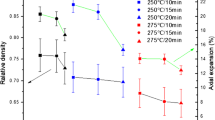Abstract
The effects of temperature on the product quality of wood pellet torrefaction were examined by performing experiments, proximate analysis, ultimate analysis, heating value measurement, thermogravimetric analysis, and moisture absorption of torrefied wood pellets at 250, 300, 350, and 400 °C. The liquids produced during torrefaction and high-temperature pyrolysis of torrefied wood pellet at 800 °C were also analyzed. By increasing the torrefaction temperature to 400 °C, the yield of the solid was decreased to 30.32%, with an increase in gas (17.53%) and liquid (52.16%) yield caused by the partial elimination and decomposition of hemicellulose, cellulose, and lignin of wood pellet. The higher heating value of wood pellets was increased from 4,670 kcal/kg for raw wood pellets to 7,480 kcal/kg for torrefied wood pellets at 400 °C with the carbon concentration during torrefaction. Although the carbon density and heating value of the wood pellets were improved, overall energy recovery efficiency was decreased because of the decrease in solid yield by torrefaction. Thermogravimetric analysis results suggested that thermally stable wood pellet formation is formed by the elimination and structural changes to hemicellulose, cellulose, and lignin. The hydrophobicity of wood pellets was increased by torrefaction leading to the elimination of the hydrophilic functional groups of wood pellets. The moisture absorption of wood pellets (14.95%) was also decreased to 5.09% for torrefied wood pellets. Low-temperature torrefaction between 250 and 300 °C produced the typical pyrolyzates of hemicellulose and cellulose, such as furans and acids. The amount of lignin pyrolyzates, such as guaiacol, eugenol, and other phenolics, was increased by applying high-temperature torrefaction at 400 °C. The solid fuel produced by the high-temperature torrefaction of wood pellets also provided a potential decreasing tar content during gasification, indicating the improved process efficiency of torrefied wood pellets.
Similar content being viewed by others
References
IEA (2021), World Energy Outlook 2021, IEA, Paris https://www.iea.org/reports/world-energy-outlook-2021.
Y. H. Oh, I. Y. Eom, J. C. Joo, J. H. Yu, B. K. Song, S. H. Lee, S. H. Hong and S. J. Park, Korean J. Chem. Eng., 32, 1945 (2015).
W. H. Chen, J. Peng and X. T. Bi, Renew. Sust. Energ. Rev., 44, 847 (2015).
C. G. Lee, M. J. Kim and C. D. Eom, BioResources, 17(1), 411 (2022).
Y. Niu, Y. Lv, Y. Lei, S. Liu, Y. Liang, D. Wang and S. Hui, Renew. Sust. Energ. Rev., 115, 109395 (2019).
A. E. Eseyin, P. H. Steele, C. U. PittmanJr., K. I. Ekpenyong and B. Soni, Biofuels, 7(1), 20 (2016).
J. Meng, J. Park, D. Tilotta and S. Park, Bioresour. Technol., 111, 439 (2012).
S. U. Lee, K. Jung, G. W. Park, C. Seo, Y. K. Hong, W. H. Hong and H. N. Chang, Korean J. Chem. Eng., 29, 831 (2012).
L. Kumar, A. A. Koukoulas, S. Mani and J. Satyavolu, Energy Fuels, 31(1), 37 (2017).
J. S. Jeong, G. M. Kim, H. J. Jeong, G. B. Kim and C. H. Jeon, Trans. Korean Hydrogen New Energy Soc., 30(1), 49 (2019).
T. U. Han, Y. M. Kim, C. Watanabe, N. Teramae, Y. K. Park, S. Kim and Y. Lee, J. Ind. Eng. Chem., 32, 345 (2015).
Y. M. Kim, J. Jae, B. S. Kim, Y. Hong, S. C. Jung and Y. K. Park, Energy Convers. Manag., 149, 966 (2017).
A. Anca-Couce, Prog. Energy Combust. Sci., 53, 41 (2016).
J. Wang, B. Shen, D. Kang, P. Yuan and C. Wu, Chem. Eng. Sci., 195, 767 (2019).
D. Mohan, C. U. PittmanJr. and P. H. Steele, Energy Fuels, 20(3), 848 (2006).
P. K. Dikshit, H. B. Jun and B. S. Kim, Korean J. Chem. Eng., 37(3), 387 (2020).
Y. H. Park, J. Kim, S. S. Kim and Y. K. Park, Bioresour. Technol., 100, 400 (2009).
L. Zhu and Z. Zhong, Korean J. Chem. Eng., 37, 1660 (2020).
P. R. Patwardhan, R. C. Brown and B. H. Shanks, ChemSusChem, 4, 1629 (2011).
H. J. Park, J. I. Dong, J. S. Kim, J. K. Jeon, S. S. Kim, J. Kim, B. Song, J. Park, K. J. Lee and Y. K. Park, Fuel Process. Technol., 90, 186 (2009).
Y. K. Park, M. L. Yoo, H. W. Lee, S. S. Park, S. C. Kim, S. H. Park and S. C. Jung, Renew. Energy, 42, 125 (2012).
D. A. Granados, R. A. Ruiz, L. Y. Vega and F. Chejne, Energy, 139, 818 (2017).
J. Park, J. Meng, K. H. Lim, O. J. Rojas and S. Park, J. Anal. Appl. Pyrolysis, 100, 199 (2013).
K. Manatura, Case Stud. Therm. Eng., 19, 100623 (2020).
C. R. Lee, J. S. Yoon, Y. W. Suh, J. W. Choi, J. M. Ha, D. J. Suh and Y. K. Park, Catal. Commun., 17, 54 (2012).
H. J. Park, S. H. Park, J. M. Sohn, J. Park, J. K. Keon, S. S. Kim and Y. K. Park, Bioresour. Technol., 101, S101 (2010).
Acknowledgements
This work was supported by Korea Institute of Planning and Evaluation for Technology in Food, Agriculture and Forestry (IPET) and Korea Smart Farm R&D Foundation (KosFarm) through Smart Farm Innovation Technology Development Program, funded by Ministry of Agriculture, Food and Rural Affairs (MAFRA) and Ministry of Science and ICT (MSIT), Rural Development Administration (RDA) (421037031HD020), and this work was supported by the Korea Ministry of Environment as Waste to Energy-Recycling Human Resource Development Project (YL-WE-22-001).
Author information
Authors and Affiliations
Corresponding authors
Rights and permissions
About this article
Cite this article
Park, C., Jang, ES. & Kim, YM. The temperature effect on the production of liquid and solid fuel via wood pellet torrefaction. Korean J. Chem. Eng. 40, 1373–1379 (2023). https://doi.org/10.1007/s11814-022-1305-y
Received:
Revised:
Accepted:
Published:
Issue Date:
DOI: https://doi.org/10.1007/s11814-022-1305-y




